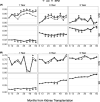Predicting kidney graft function and failure among kidney transplant recipients
- PMID: 39736573
- PMCID: PMC11687162
- DOI: 10.1186/s12874-024-02445-6
Predicting kidney graft function and failure among kidney transplant recipients
Abstract
Background: Graft loss is a major health concern for kidney transplant (KTx) recipients. It is of clinical interest to develop a prognostic model for both graft function, quantified by estimated glomerular filtration rate (eGFR), and the risk of graft failure. Additionally, the model should be dynamic in the sense that it adapts to accumulating longitudinal information, including time-varying at-risk population, predictor-outcome association, and clinical history. Finally, the model should also properly account for the competing risk by death with a functioning graft. A model with the features above is not yet available in the literature and is the focus of this research.
Methods: We built and internally validated a prediction model on 3,893 patients from the Wisconsin Allograft Recipient Database (WisARD) who had a functioning graft 6 months after kidney transplantation. The landmark analysis approach was used to build a proof-of-concept dynamic prediction model to address the aforementioned methodological issues: the prediction of graft failure, accounted for competing risk of death, as well as the future eGFR value, are updated at each post-transplant time. We used 21 predictors including recipient characteristics, donor characteristics, transplant-related and post-transplant factors, longitudinal eGFR, hospitalization, and rejection history. A sensitivity analysis explored a less conservative variable selection rule that resulted in a more parsimonious model with reduced predictors.
Results: For prediction up to the next 1 to 5 years, the model achieved high accuracy in predicting graft failure, with the AUC between 0.80 and 0.95, and moderately high accuracy in predicting eGFR, with the root mean squared error between 10 and 18 mL/min/1.73m2 and 70%-90% of predicted eGFR falling within 30% of the observed eGFR. The model demonstrated substantial accuracy improvement compared to a conventional prediction model that used only baseline predictors.
Conclusion: The model outperformed conventional prediction model that used only baseline predictors. It is a useful tool for patient counseling and clinical management of KTx and is currently available as a web app.
Keywords: Competing risk; Dynamic prediction; Graft failure; Kidney transplantation; Renal function.
© 2024. The Author(s).
Conflict of interest statement
Declarations. Ethics approval and consent to participate: This research has been approved by the Institutional Review Board of the participating institutions. The authors abided by guidelines laid out by the Declaration of Helsinki. The clinical and research activities being reported are consistent with the Principles of the Declaration of Istanbul as outlined in the “Declaration of Istanbul on Organ Trafficking and Transplant Tourism”. Since this research is secondary analysis of de-identified data, conducted at MD Anderson Cancer Center, the need for obtaining consent from study participants was waived by the Institutional Review Board of MD Anderson. Consent for publication: Not applicable. Competing interests: The authors declare no competing interests.
Figures


Similar articles
-
Dynamic prediction models for graft failure in paediatric kidney transplantation.Nephrol Dial Transplant. 2021 Apr 26;36(5):927-935. doi: 10.1093/ndt/gfaa180. Nephrol Dial Transplant. 2021. PMID: 32989448
-
Association between a change in donor kidney function and long-term allograft outcomes in kidney transplant recipients.Artif Organs. 2015 Mar;39(3):254-9. doi: 10.1111/aor.12367. Epub 2014 Sep 10. Artif Organs. 2015. PMID: 25205383
-
Living donor postnephrectomy kidney function and recipient graft loss: A dose-response relationship.Am J Transplant. 2018 Nov;18(11):2804-2810. doi: 10.1111/ajt.15061. Epub 2018 Aug 31. Am J Transplant. 2018. PMID: 30086198 Free PMC article.
-
Multivariable Predictors of Poorer Renal Function Among 1119 Deceased Donor Kidney Transplant Recipients During the First Year Post-Transplant, With a Particular Focus on the Influence of Individual KDRI Components and Donor AKI.Clin Transplant. 2025 Apr;39(4):e70080. doi: 10.1111/ctr.70080. Clin Transplant. 2025. PMID: 40226903 Free PMC article.
-
The impact of donor and recipient common clinical and genetic variation on estimated glomerular filtration rate in a European renal transplant population.Am J Transplant. 2019 Aug;19(8):2262-2273. doi: 10.1111/ajt.15326. Epub 2019 Mar 28. Am J Transplant. 2019. PMID: 30920136 Free PMC article.
References
-
- Kasiske BL, Israni AK, Snyder JJ, Skeans MA, Peng Y, Weinhandl ED. A simple tool to predict outcomes after kidney transplant. Am J Kidney Dis. 2010;56(5):947–60. - PubMed
-
- Pieloch D, Dombrovskiy V, Osband AJ, DebRoy M, Mann RA, Fernandez S, et al. The Kidney Transplant Morbidity Index (KTMI): a simple prognostic tool to help determine outcome risk in kidney transplant candidates. Prog Transplant. 2015;25(1):70–6. - PubMed
-
- Kaboré R, Haller MC, Harambat J, Heinze G, Leffondré K. Risk prediction models for graft failure in kidney transplantation: a systematic review. Nephrol Dial Transplant. 2017;32(suppl_2):ii68–76. - PubMed
MeSH terms
LinkOut - more resources
Full Text Sources
Medical
Research Materials
Miscellaneous

